|
quick_sort1.f.html |
 |
|
Source file: quick_sort1.f
|
|
Directory: /home/rjl/git/rjleveque/clawpack-4.x/amrclaw/2d/lib
|
|
Converted: Sun May 15 2011 at 19:16:15
using clawcode2html
|
|
This documentation file will
not reflect any later changes in the source file.
|
C From HDK@psuvm.psu.edu Thu Dec 8 15:27:16 MST 1994
C
C The following was converted from Algol recursive to Fortran iterative
C by a colleague at Penn State (a long time ago - Fortran 66, please
C excuse the GoTo's). The following code also corrects a bug in the
C Quicksort algorithm published in the ACM (see Algorithm 402, CACM,
C Sept. 1970, pp 563-567; also you younger folks who weren't born at
C that time might find interesting the history of the Quicksort
C algorithm beginning with the original published in CACM, July 1961,
C pp 321-322, Algorithm 64). Note that the following algorithm sorts
C integer data; actual data is not moved but sort is affected by sorting
C a companion index array (see leading comments). The data type being
C sorted can be changed by changing one line; see comments after
C declarations and subsequent one regarding comparisons(Fortran
C 77 takes care of character comparisons of course, so that comment
C is merely historical from the days when we had to write character
C compare subprograms, usually in assembler language for a specific
C mainframe platform at that time). But the following algorithm is
C good, still one of the best available.
SUBROUTINE QSORTI (ORD,N,A)
C
C==============SORTS THE ARRAY A(I),I=1,2,...,N BY PUTTING THE
C ASCENDING ORDER VECTOR IN ORD. THAT IS ASCENDING ORDERED A
C IS A(ORD(I)),I=1,2,...,N; DESCENDING ORDER A IS A(ORD(N-I+1)),
C I=1,2,...,N . THIS SORT RUNS IN TIME PROPORTIONAL TO N LOG N .
C
C
C ACM QUICKSORT - ALGORITHM #402 - IMPLEMENTED IN FORTRAN 66 BY
C WILLIAM H. VERITY, WHV@PSUVM.PSU.EDU
C CENTER FOR ACADEMIC COMPUTING
C THE PENNSYLVANIA STATE UNIVERSITY
C UNIVERSITY PARK, PA. 16802
C
IMPLICIT INTEGER (A-Z)
C
DIMENSION ORD(N),POPLST(2,20)
integer X,XX,Z,ZZ,Y
C
C TO SORT DIFFERENT INPUT TYPES, CHANGE THE FOLLOWING
C SPECIFICATION STATEMENTS; FOR EXAMPLE, FOR FORTRAN CHARACTER
C USE THE FOLLOWING: CHARACTER *(*) A(N)
C
integer A(N)
C
NDEEP=0
U1=N
L1=1
DO 1 I=1,N
1 ORD(I)=I
2 IF (U1.LE.L1) RETURN
C
3 L=L1
U=U1
C
C PART
C
4 P=L
Q=U
C FOR CHARACTER SORTS, THE FOLLOWING 3 STATEMENTS WOULD BECOME
C X = ORD(P)
C Z = ORD(Q)
C IF (A(X) .LE. A(Z)) GO TO 2
C
C WHERE "CLE" IS A LOGICAL FUNCTION WHICH RETURNS "TRUE" IF THE
C FIRST ARGUMENT IS LESS THAN OR EQUAL TO THE SECOND, BASED ON "LEN"
C CHARACTERS.
C
X=A(ORD(P))
Z=A(ORD(Q))
IF (X.LE.Z) GO TO 5
Y=X
X=Z
Z=Y
YP=ORD(P)
ORD(P)=ORD(Q)
ORD(Q)=YP
5 IF (U-L.LE.1) GO TO 15
XX=X
IX=P
ZZ=Z
IZ=Q
C
C LEFT
C
6 P=P+1
IF (P.GE.Q) GO TO 7
X=A(ORD(P))
IF (X.GE.XX) GO TO 8
GO TO 6
7 P=Q-1
GO TO 13
C
C RIGHT
C
8 Q=Q-1
IF (Q.LE.P) GO TO 9
Z=A(ORD(Q))
IF (Z.LE.ZZ) GO TO 10
GO TO 8
9 Q=P
P=P-1
Z=X
X=A(ORD(P))
C
C DIST
C
10 IF (X.LE.Z) GO TO 11
Y=X
X=Z
Z=Y
IP=ORD(P)
ORD(P)=ORD(Q)
ORD(Q)=IP
11 IF (X.LE.XX) GO TO 12
XX=X
IX=P
12 IF (Z.GE.ZZ) GO TO 6
ZZ=Z
IZ=Q
GO TO 6
C
C OUT
C
13 CONTINUE
IF (.NOT.(P.NE.IX.AND.X.NE.XX)) GO TO 14
IP=ORD(P)
ORD(P)=ORD(IX)
ORD(IX)=IP
14 CONTINUE
IF (.NOT.(Q.NE.IZ.AND.Z.NE.ZZ)) GO TO 15
IQ=ORD(Q)
ORD(Q)=ORD(IZ)
ORD(IZ)=IQ
15 CONTINUE
IF (U-Q.LE.P-L) GO TO 16
L1=L
U1=P-1
L=Q+1
GO TO 17
16 U1=U
L1=Q+1
U=P-1
17 CONTINUE
IF (U1.LE.L1) GO TO 18
C
C START RECURSIVE CALL
C
NDEEP=NDEEP+1
POPLST(1,NDEEP)=U
POPLST(2,NDEEP)=L
GO TO 3
18 IF (U.GT.L) GO TO 4
C
C POP BACK UP IN THE RECURSION LIST
C
IF (NDEEP.EQ.0) GO TO 2
U=POPLST(1,NDEEP)
L=POPLST(2,NDEEP)
NDEEP=NDEEP-1
GO TO 18
C
C END SORT
C END QSORT
C
END

